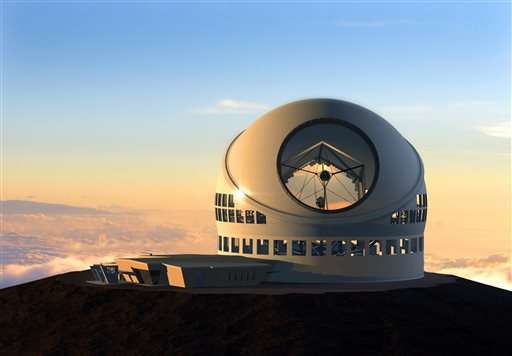What's at stake in battle over Hawaii telescope

Scientists hoping to build a telescope that will allow them to see 13 billion light years away, giving them a look into the early years of the universe, are facing opposition from Native Hawaiian groups who say the construction site is on sacred land. After a pause in construction to hold discussions on the issue, Thirty Meter Telescope plans to resume construction on the site Wednesday. Protesters are standing their ground and are prepared to be arrested to stop the construction.
___
WHAT'S HAPPENING
Construction of the Thirty Meter Telescope began in March near the summit of Mauna Kea on the Big Island of Hawaii after seven years of environmental studies, public hearings and court proceedings.
The land, which is managed by the University of Hawaii and subleased to Thirty Meter Telescope, is considered sacred by Native Hawaiian groups. They don't oppose the telescope itself, but they strongly disagree with its location atop the dormant volcano.
The nonprofit company building the telescope suspended construction in April after law enforcement arrested protesters for blocking the road to the summit and refusing to leave the construction site. On Saturday, telescope officials announced construction would resume Wednesday.
A lawsuit challenging the project's construction permit is pending before the state Supreme Court, which is scheduled to hear oral arguments Aug. 27.
___
HISTORY OF SPACE OBSERVATION ATOP MAUNA KEA
The first road to the summit was built in 1964, and the University of Hawaii built the first telescope four years later. Universities from around the world and NASA built about a dozen other telescopes in subsequent decades.
A state Board of Land and Natural Resources report in 2013 said little consideration was given to how these facilities might affect traditional culture because "the significance wasn't understood at the time."
In 2007, scientists abandoned a plan to build six smaller outrigger telescopes after a judge ruled they needed a management plan for the conservation and protection of the entire summit to proceed.
The state approved the University of Hawaii's summit management plan in 2009. The Thirty Meter Telescope is the first observatory to receive a construction permit since the outrigger project failed.
___
THE SACRED NATURE OF MAUNA KEA
Some Native Hawaiians believe the top of Mauna Kea is where their creation story began. Kealoha Pisciotta, an opponent of the telescope project and a protest organizer, says "it is the burial grounds of some of our most sacred and revered ancestors. It is a place where we go for sanctuary and release from the world around us, and it is also the home of our god."
All of the highest points in the islands are considered the home of deities, she said. In the past, only high chiefs and priests were allowed at Mauna Kea's summit.
___
WHAT SCIENTISTS HOPE TO LEARN
Once constructed, the telescope will allow astronomers and scientists to view some of the very first stars and galaxies in the universe, research black holes and help understand dark matter. Peering this far back in time, a few hundred million years after the Big Bang, will give scientists the opportunity to explore fundamental questions about dark matter and dark energy, information that could allow them to make conclusions about the future of our universe.
___
WHY ASTRONOMERS LIKE THIS LOCATION
Its summit at 13,796 feet (4,205 meters) is well above the clouds, offering a clear view of the sky above for 300 days a year. Hawaii's isolated location in the middle of the Pacific Ocean also means the area is relatively free of air pollution.
There are few cities on the Big Island, meaning there also aren't a lot of man-made lights around to disrupt observations. Thirty Meter Telescope intends to build on a northern plateau to minimize effects on native bug habitat, cultural practices, view planes and historic sites.
___
WHO IS BEHIND THE THIRTY METER TELESCOPE PROJECT?
Thirty Meter Telescope is a California nonprofit formed by the University of California and the California Institute of Technology. Institutions in Canada, China, India and Japan and signed on as partners and would receive a share of observing time. University of Hawaii scientists would also have a share.
___
WHO ARE THE OPPONENTS?
The movement to oppose the telescope exploded on social media with celebrities such actor Jason Momoa, who is Native Hawaiian, supporting the cause. A group of protesters—who call themselves protectors—have been camping on the mountain, bracing for when construction resumes. They sleep in vehicles or on cots under a tent, bundling up in temperatures that in recent days have dipped to about 30 degrees at night.
© 2015 The Associated Press. All rights reserved.




















